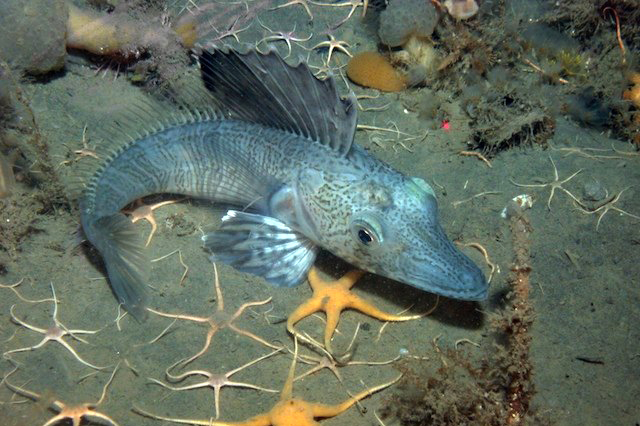Mackeral Icefish, Champsocephalus gunnari Lönnberg 1905

A Mackeral Icefish, Champsocephalus gunnari. Source: Julian Gutt / Alfred Wegener Institute. License: CC BY Attribution-NonCommercial-ShareAlike
A crocodile icefish found in the Southern Ocean in Australia's subantarctic waters.
Crocodile icefishes are remarkably adapted to life in the near-freezing waters of the Southern Ocean. They are unique among vertebrates in having blood that lacks red blood cells and the red oxygen-carrying pigment, haemoglobin, in their blood. Their blood also contains a special 'anti-freeze' chemical that prevents the build-up of ice crystals in their bodies.
Mackeral Icefish, Champsocephalus gunnari Lönnberg 1905
More Info
|
Distribution |
Widespread in the Southern Ocean, mostly around Heard and McDonald Islands in the Australian EEZ, and islands in the south Atlantic such as South Georgia. Schools of Mackeral Icefish undertake daily vertical migrations to feed at night on krill, small fishes and zooplankton. Inhabit depths up to 700m; larger juveniles and adults form large schools either at or near the sea floor, or in mid-water. |
|
Feeding |
Carnivores - feed on krill and small fishes. |
|
Biology |
A short-lived, fast growing species reaching a length of about 66 cm and 2 kg in weight. Sexual maturity is reached at lengths between 22-26 cm (3-4 years). |
|
Fisheries |
Fished commercially off Heard and MacDonald islands in Australia's subantarctic waters. The species is taken in bottom and midwater trawls. Trawl nets are limited to a minimum mesh size of 90 mm when targeting mackerel icefish to enable juvenile fish to escape the net. The Australian mackerel icefish fishery has been certified by the Marine Stewardship Council as well-managed and sustainable. |
|
Species Citation |
Champsocephalus gunnari Lönnberg 1905: Wissenschaftliche Ergebnisse der Schwedischen Südpolar-Expedition, 1901-1903 5(6): 37. Type locality: South Georgia Island, station 22, depth 75 m, and station 32, depth 195 m. |
|
Author |
Dianne J. Bray |
Mackeral Icefish, Champsocephalus gunnari Lönnberg 1905
References
AFMA. 2013. Status Report Heard Island and McDonald Islands Fishery. Report to the Department of Sustainability, Environment, Water, Population and Communities.
Balushkin, A.V. 1996. Similarity of fish of family Channichthyidae (Notothenioidei, Perciformes), with remarks on the species composition of the family and the description of a new species from the Kerguelen Archipelago. J. Ichthyol. 36(1): 1-10.
Christiansen, J.S., S.E. Fevolden, O.V. Karamushlo & L.I. Karamushko. 1997. Reproductive traits of marine fish in relation to their mode of oviposition and zoogeographic distribution. ICES CM 1997/CC. 14 pp.
Croxall, J.P., Reid, K. & Prince, P.A. 1999. Diet, provisioning and productivity responses of marine predators to differences in availability of Antarctic krill. Mar. Ecol. Prog. Ser. 177: 115-131.
Efremenko, V.N. 1979. Descriptions of larvae of six species of the family Chaenichthyidae from the Scotia Sea. J. Ichthyol. 19: 65-75.
Iwami, T. & K.-H. Kock. 1990. Channichthyidae. p. 381-389. In: O. Gon and P.C. Heemstra (eds.) Fishes of the Southern Ocean. J.L.B. Smith Institute of Ichthyology, Grahamstown, South Africa. 462 pp.
Kellermann, A. (ed.) 1990. Identification key and catalogue of larval Antarctic fishes. Ber. Polarforsch. 67: 1-136.
Kellermann, A. & K.-H. Kock. 1984. Postlarval and juvenile notothenioids (Pisces, Perciformes) in the southern Scotia Sea and northern Weddell Sea during FIBEX 1981. Meeresforsch. 30: 82-93.
Kochkin, P.N. 1985. Analysis of the age sensitive structures and linear growth in the pike glassfish, Champsocephalus gunnari (Channichthyidae). J. Ichthyol. 25(5): 110-119.
Kochkin, P.N., 1995. On estimates of natural mortality of the mackerel icefish,Champsocephalus gunnari (Channichthyidae), in the South Georgia Island area. J. Ichthyol. 35(7): 153-157.
Kock, K.-H. & A. Kellermann. 1991. Reproduction in Antarctic notothenioid fish. Antartic Science 3(2): 125-150.
Kock, K.-H., S. Wilhelms, I. Everson & J. Gröger. 1994. Variations in the diet composition and feeding intensity of mackerel icefish Champsocephalus gunnari at South Georgia (Antarctic). Mar. Ecol. Prog. Ser. 108: 43-57.
Lönnberg, E. 1905. The fishes of the Swedish South Polar Expedition. Wissenschaftliche Ergebnisse der Schwedischen Südpolar-Expedition, 1901-1903 5(6): 1-72, Pls. 1-5.
Miller, R.G., 1993. A history and atlas of the fishes of the Antarctic Ocean. Foresta Institute, Nevada. 792 pp.
Near T.J., Parker S.K. & Detrich H.W. 2006. A genomic fossil reveals key steps in hemoglobin loss by the Antarctic icefishes. Molecular Biology and Evolution 23: 2008-2016.
North, A.W. & A. Kellermann. 1990. Key to the early stages of Antarctic fish. Ber. Polarforsch. 67: 1-44.
Patterson, H. & Skirtun, M. 2012. Heard Island and McDonald Islands Fishery. pp 356-365 In: Woodhams, J., Vieira, S. & Stobutzki, I. (eds) Fishery Status Reports 2011. Australian Bureau of Agricultural and Resource Economics and Sciences, Canberra. 440 pp.
Permitin, Y.Y. 1973. Fecundity and reproductive biology of icefish (Chaenichthidae), fish of the family Muraenolepidae and dragonfish (Bathydraconidae) of the Scotia Sea (Antarctica). J. Ichthyol. 13(2): 204-215.
Roschin, E.A., 2000. Spawning of Antarctic icefish Champsocephalus gunnari (Channichthyidae) off Kerguelen-Herd Ridge. J. Ichthyol. 40(2): 210-211.
Sidell, B.D. & K.M. O'Brien. 2006. When bad things happen to good fish: the loss of hemoglobin and myoglobin expression in Antarctic Icefishes. Journal of Experimental Biology 209(10): 1791–1802. doi:10.1242/jeb.02091. PDF
Tarverdieva, M.I., 1982. The food composition, daily ration and feeding habits of the icefish Champsocephalus gunnari off the South Orkneys. Proc. And Transactions of the All-Union Research Institute of Marine Fisheries and Oceanography. p. 69.
Welsford, D., Lamb, T. & Hay, I. 2012. Appendix 4. Antarctic Fisheries: Heard Island and McDonald Islands Patagonian toothfish and mackerel icefish fisheries. pp 29-40 In: Tuck, G.N., Knuckey, I. & Klaer, N.L. Informing the review of the Commonwealth Policy on Fisheries Bycatch through assessing trends in bycatch of key Commonwealth fisheries. Fisheries Research and Development Corporation final report 2012/046. 240 pp
Williams, R., Hunt, B.P.V., Davenport, S.R. & Lamb, T.D. 2011. Population structure, feeding biology and predation impact of midwater fishes in predator feeding areas around Heard and McDonald Islands, Southern Indian Ocean. In: Duhamel, G. & Welsford, D (eds). The Kerguelen Plateau Marine Ecosystem and Fisheries. Proceedings of the first international symposium on the Kerguelen Plateau, 14-126 April 2010.




